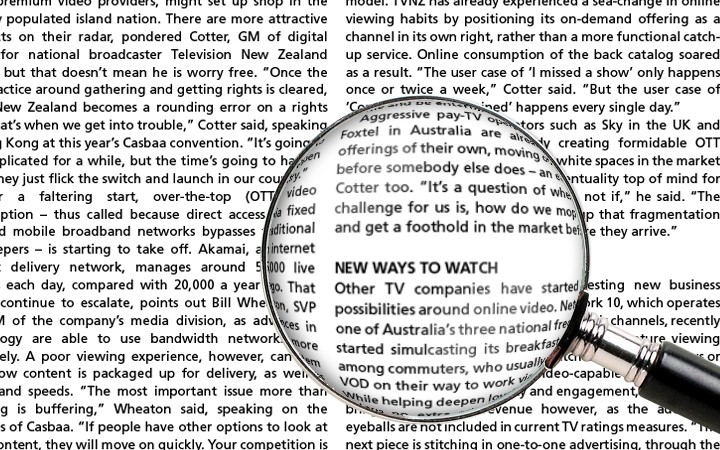
New Zealand is a long way from Hollywood and Silicon Valley, observed local TV executive Tom Cotter, speculating as to whether Hulu and Netflix, two of the world’s most talked-about premium video providers, might set up shop in the sparsely populated island nation.
There are more attractive prospects on their radar, pondered Cotter, GM of digital media for national broadcaster Television New Zealand (TVNZ), but that doesn’t mean he is worry free.
“Once the best practice around gathering and getting rights is cleared, when New Zealand becomes a rounding error on a rights deal, that’s when we get into trouble,” Cotter said, speaking in Hong Kong at this year’s Casbaa convention.
“It’s going to be complicated for a while, but the time’s going to happen when they just flick the switch and launch in our country.”
After a faltering start, over-the-top (OTT) video consumption – thus called because direct access via fixed line and mobile broadband networks bypasses traditional gatekeepers – is starting to take off.
Akamai, an internet content delivery network, manages around 55,000 live streams each day, compared with 20,000 a year ago.
That should continue to escalate, points out Bill Wheaton, SVP and GM of the company’s media division, as advances in technology are able to use bandwidth networks more effectively.
A poor viewing experience, however, can stem from how content is packaged up for delivery, as well as broadband speeds.
“The most important issue more than anything is buffering,” Wheaton said, speaking on the sidelines of Casbaa.
“If people have other options to look at other content, they will move on quickly. Your competition is only one click away.”
Time spent watching TV content online is still nowhere near traditional linear TV, which in New Zealand for example still makes up 97% of total viewing.
Online video’s appeal among everyday consumers is hobbled by a poor selection of legal shows (rights-holders with the best shows tend to favor traditional licensing, where they can make more money), as well as poor user interfaces, particularly on smart TVs.
Which is just as well, because if everybody did watch their favorite shows online, today’s broadband networks wouldn’t be able to cope.
Peak internet consumption rates, estimated at 30 petabytes (about 30 million GB), are less than 0.1% of the amount that would be required should current viewing habits migrate online.
That would push up traffic by an order of magnitude (to about 50,000 petabytes, according to the experts).
“There’s a long way to go, to carry all the linear viewing,” Cotter ruefully remarked.
The evolution of online video has only just begun, creating greenfield opportunities to tap consumer incomes as well as ad budgets.
In New Zealand, ad-free content might not be enough to tempt people to pay, but a premium service delivering express content from the US might, Cotter mused – though to be economically viable, it should probably be launched as a subscription-based rather than pay-per-view model.
TVNZ has already experienced a sea-change in online viewing habits by positioning its on-demand offering as a channel in its own right, rather than a more functional catch-up service. Online consumption of the back catalog soared as a result.
“The user case of ‘I missed a show’ only happens once or twice a week,” Cotter said. “But the user case of ‘Come and be entertained’ happens every single day.”
Aggressive pay-TV operators such as Sky in the UK and Foxtel in Australia are already creating formidable OTT offerings of their own, moving on white spaces in the market before somebody else does – an eventuality top of mind for Cotter too.
“It’s a question of when, not if,” he said. “The challenge for us is, how do we mop up that fragmentation and get a foothold in the market before they arrive.”
Other TV companies have started testing new business possibilities around online video.
Network 10, which operates one of Australia’s three national free-to-air channels, recently started simulcasting its breakfast show to capture viewing among commuters, who usually watch downloaded shows or VOD on their way to work via video-capable mobile devices.
While helping deepen loyalty and engagement, the initiative brings no extra ad revenue however, as the additional eyeballs are not included in current TV ratings measures.
“The next piece is stitching in one-to-one advertising, through the technology, and effectively replacing the broadcast ads with digital ads,” said Mark Blair, VP of media solutions in APAC for online video hosting platform Brightcove, speaking to Media Business Asia.
“You can get incremental revenue from that, which starts to get interesting,” he added.
For rights-holders meanwhile, renewed competition in distribution is good news, pushing up the value of their content.
Falling technology costs are making it increasingly cost effective to skip the middleman and go direct to consumers, a plausible alternative if there are no other offers on the table.
It’s something Asian mixed martial arts property Legend Fighting Championship is looking at, having sold pay-per-view rights for some markets via Ustream, but only in places without a TV partner.
“In China and Southeast Asia, we have strong broadcaster relationships,” said MD Chris Pollak, also speaking at Casbaa.
“They have enormous audiences, and there’s a lot we can do together that Legend wouldn’t be able to do on our own. We value those relationships.”

As a leading independent consulting and research provider focused on Asia media & telecoms, MPA offers a range of customized services to help drive business development, strategy & planning, M&A, new products & services and research. Based in Hong Kong, Singapore and India, MPA teams offer in-depth research reports across key industry sectors, customized consulting services, industry events to spread knowledge and unlock partnerships, and publications that provide insights into media & telecoms.
All Media Partners Asia articles >Thank you for submission
Once you activate the account, your subscription entitles to receive 3 months of complimentary access to ‘The Digest’, MPA’s monthly email analysis,updates across TMT with exclusive industry interviews and data.